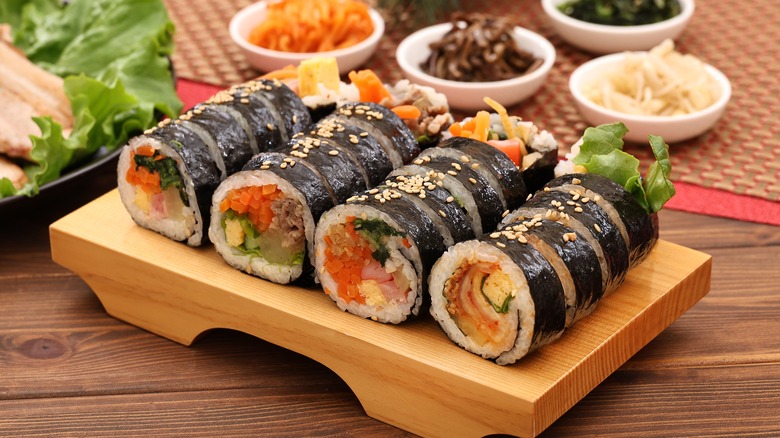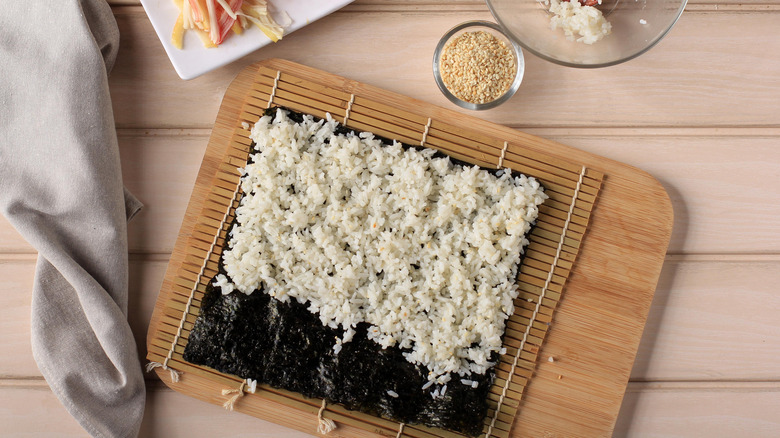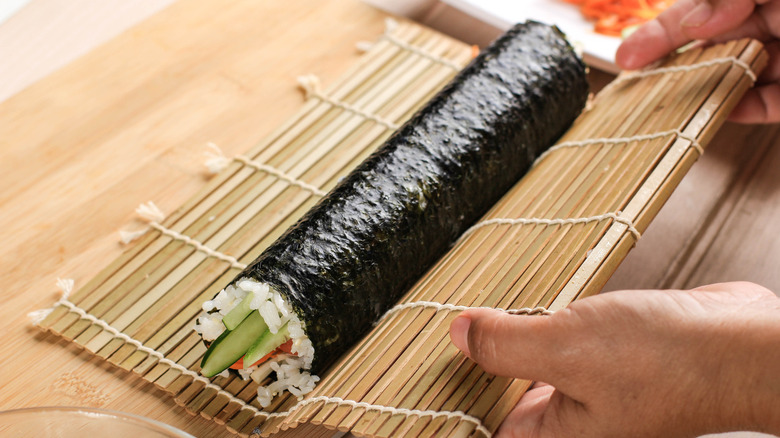Chef-Approved Tips For Making Restaurant-Worthy Kimbap At Home
If you have been waiting for the universe to send you a sign to try making kimbap at home, this is it. As a versatile traditional Korean dish you need to try at least once, kimbap might also make it on your bucket list to make in your own kitchen. Abandon all fear and apprehensions at the kitchen door, because here are some indispensable tips for making beautiful and delicious kimbap shared by Ji Hye Kim, chef and owner of the Korean restaurant Miss Kim in Ann Arbor, Michigan.
According to Kim, the basic formula of kimbap is something "vegetable heavy, something crunchy, something acidic like pickled radishes, and a protein of choice." Whether it is sauteed julienned carrots or spinach, crunchy pickled yellow radishes, and seasoned beef, or more unorthodox ingredients like bacon, lettuce, and tomato that you choose to include, it is hard to go wrong with the basic formula of kimbap. Once you have picked your dream combination of kimbap ingredients, you are ready to heed Chef Kim's other advice on rice, seaweed wraps, cutting kimbap, and rolling kimbap.
Advice for the seaweed, rice, and slicing
Your flavorful ingredient combination will eventually find its home on the bed of rice. Chef Ji Hye Kim advises that the rice be spread evenly and thinly on the seaweed sheet, or kimbap gim. As for how much of the seaweed sheet should be covered with rice, Kim leaves half an inch or so at the top of the sheet free of rice, so that it can be wet during the rolling process (more on that below). Lightly wetting this part of the seaweed sheet will help the roll stick closed.
Just as there are some rice brands to buy and some to avoid, there are also characteristics of seaweed wrap that influence which should be chosen for making kimbap. Kim advises using high quality seaweed wrap on the thicker side; wrapping with kimbap gim of lesser quality may not keep the ingredients together as well when you roll it.
When it comes time to cut the kimbap into discs, Kim advises that each Wonder Bread-sized slice begin with small sawing motions until the sharp knife breaks through the seaweed wrap. At that point, you can switch to slicing as normal. Wiping the knife every few slices will keep the rice from sticking and other ingredients from being dragged out of place. Once you have finished slicing the kimbap, you are ready to enjoy a homemade, restaurant-worthy version of one of the healthiest East Asian takeout meals.
Rolling kimbap is an act of care
Chef Ji Hye Kim uses the imagery of tucking something into a blanket to explain the neatness and gentleness that goes into rolling kimbap with a seaweed sheet. "When I was learning to make kimbap, it helped me a lot to think of the seaweed sheet as the blanket to cover all the filling, rather than a roll," she explains. Using a bamboo sushi mat will also help.
After placing the kimbap ingredients in the middle of the seaweed wrap, "Take the end closer to you [which would be the bottom of the sheet] and gently blanket over the ingredients just enough so they're completely covered," she says. "Tuck the bottom end that you just moved over to cover the ingredients and pull just a little toward you to [in order to] squeeze and ensure that the ingredients are in there tightly and there is not a lot of air [or] extra space."
After the ingredients are tightly packed, it is time to roll and close off the ends of the kimbap. Once closed, Chef Kim suggests using the sushi mat itself to gently and evenly squeeze the kimbap, guiding the kimbap to its signature round shape. The roll can then be brushed with sesame oil until it achieves the perfect amount of shine and sprinkled with sesame seeds. The key at this step is to not overdo the sesame oil lest the kimbap become too oily.


